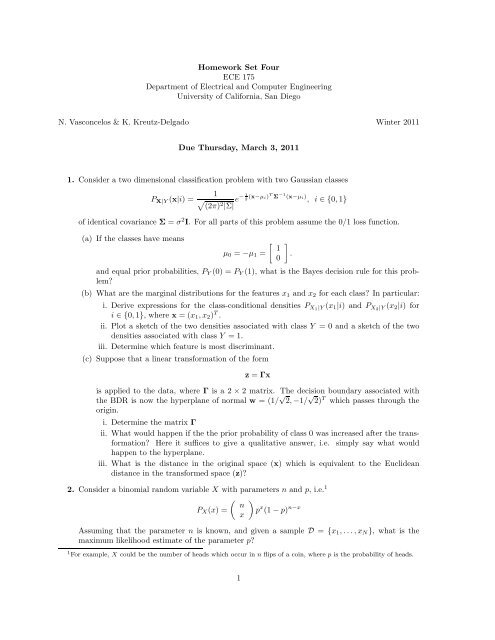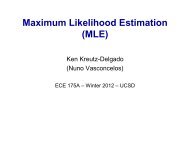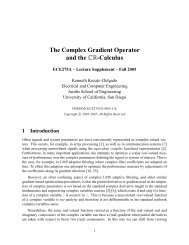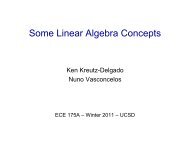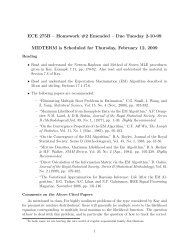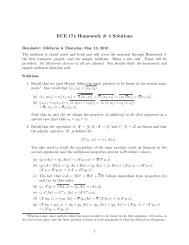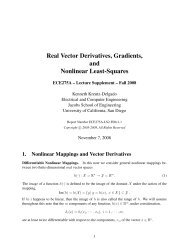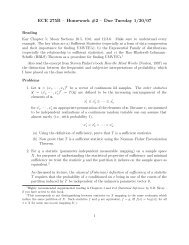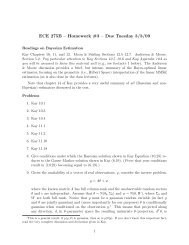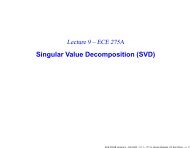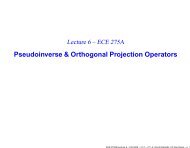Homework Set Four ECE 175 Department of ... - UCSD DSP Lab
Homework Set Four ECE 175 Department of ... - UCSD DSP Lab
Homework Set Four ECE 175 Department of ... - UCSD DSP Lab
Create successful ePaper yourself
Turn your PDF publications into a flip-book with our unique Google optimized e-Paper software.
<strong>Homework</strong> <strong>Set</strong> <strong>Four</strong><br />
<strong>ECE</strong> <strong>175</strong><br />
<strong>Department</strong> <strong>of</strong> Electrical and Computer Engineering<br />
University <strong>of</strong> California, San Diego<br />
N. Vasconcelos & K. Kreutz-Delgado Winter 2011<br />
Due Thursday, March 3, 2011<br />
1. Consider a two dimensional classification problem with two Gaussian classes<br />
P X|Y (x|i) =<br />
1<br />
1 − e 2<br />
(2π) 2 |Σ| (x−µi)T Σ −1 (x−µi)<br />
, i ∈{0, 1}<br />
<strong>of</strong> identical covariance Σ = σ 2 I. For all parts <strong>of</strong> this problem assume the 0/1 loss function.<br />
(a) If the classes have means<br />
μ0 = −μ1 =<br />
and equal prior probabilities, PY (0) = PY (1), what is the Bayes decision rule for this problem?<br />
(b) What are the marginal distributions for the features x1 and x2 for each class? In particular:<br />
i. Derive expressions for the class-conditional densities PX1|Y (x1|i) andPX2|Y (x2|i) for<br />
i ∈{0, 1}, wherex =(x1,x2) T .<br />
ii. Plot a sketch <strong>of</strong> the two densities associated with class Y = 0 and a sketch <strong>of</strong> the two<br />
densities associated with class Y =1.<br />
iii. Determine which feature is most discriminant.<br />
(c) Suppose that a linear transformation <strong>of</strong> the form<br />
z = Γx<br />
is applied to the data, where Γ is a 2 × 2 matrix. The decision boundary associated with<br />
the BDR is now the hyperplane <strong>of</strong> normal w =(1/ √ 2, −1/ √ 2) T which passes through the<br />
origin.<br />
i. Determine the matrix Γ<br />
ii. What would happen if the the prior probability <strong>of</strong> class 0 was increased after the transformation?<br />
Here it suffices to give a qualitative answer, i.e. simply say what would<br />
happen to the hyperplane.<br />
iii. What is the distance in the original space (x) which is equivalent to the Euclidean<br />
distance in the transformed space (z)?<br />
1<br />
0<br />
2. Consider a binomial random variable X with parameters n and p, i.e. 1<br />
PX(x) =<br />
n<br />
x<br />
<br />
.<br />
<br />
p x (1 − p) n−x<br />
Assuming that the parameter n is known, and given a sample D = {x1,...,xN }, what is the<br />
maximum likelihood estimate <strong>of</strong> the parameter p?<br />
1 For example, X could be the number <strong>of</strong> heads which occur in n flips <strong>of</strong> a coin, where p is the probability <strong>of</strong> heads.<br />
1
3. Consider an m-dimensional random vectors Y, such that 2<br />
Y = Ax + N<br />
where A is a full rank matrix and x is an unknown, but deterministic, n-dimensional vector, with<br />
n
5. Continuation <strong>of</strong> Computer Assignment.<br />
In the last two computer problems, we saw how classification <strong>of</strong> hand written digits works. This<br />
time we will move to a more general and practical situation. For this problem, you are to use the<br />
data-set given with <strong>Homework</strong> 4.<br />
We shall continue with the same training data used in the previous computer experiments, but<br />
with a new set <strong>of</strong> test data testImagesNew, which has been intentionally: 1) corrupted by noise<br />
and 2) re-scaled (attenuated) in amplitude.<br />
This corresponds to the situation where we have clean training data (which presumably has<br />
been imaged using high-quality imaging systems in under optimal lighting), but poorer quality<br />
test data corresponding to the type <strong>of</strong> run-time digits images that would be produced using<br />
inexpensive image-scanners in poorly illuminated environments. (Poor illumination leads to contrast<br />
attenuation, and pixel-noise if the scanner is low-quality.) The image on the left <strong>of</strong> Fig.1<br />
shows the case <strong>of</strong> an intensity-attenuated, noisy digital scan <strong>of</strong> the digit on the left. We want to<br />
classify such corrupted digits using a NN classifier.<br />
We shall continue with the same training data used in the previous experiment, but with a new<br />
set<strong>of</strong>testdatatestImagesNew, which has been intentionally: 1) re-scaled in amplitude, and 2)<br />
corrupted by noise.<br />
Using the Nearest Neighbor approach, we will find the training image that is nearest to an estimate<br />
<strong>of</strong> the uncorrupted test image. I.e., instead <strong>of</strong> the using the Euclidean distances between the<br />
training images and the corrupted test image, we will use the Euclidean distances between the<br />
training images and the ML estimate <strong>of</strong> the uncorrupted test image.<br />
Toward this end, we assume that a corrupted test image Y is a random vector <strong>of</strong> the form<br />
Y = a X + N<br />
i.e. the result <strong>of</strong> corrupting an unknown clean image X through 1) amplitude re-scaling by<br />
the scalar a, and 2) addition <strong>of</strong> independent zero mean Gaussian noise with variance v, i.e.<br />
N ∼G(0,vI).<br />
The approach to be used is:<br />
(a) Determine a maximum likelihood estimate (MLE), âML, <strong>of</strong> the attenuation parameter a. The<br />
simplest way to to this is if we are given given the corrupted observation y (the test image)<br />
corresponding to a known training image x. 3 In which case we can compute the conditional<br />
MLE <strong>of</strong> a, 4<br />
âML =argmaxPY|X(y|x;<br />
a, v) . (4)<br />
a<br />
(b) Given the test image y and the MLE <strong>of</strong> the parameter a, determine the maximum likelihood<br />
estimate (MLE) ˆx ML <strong>of</strong> the unknown “clean image” x, assuming the model given in Eq. (4)<br />
(but with a approximated by its maximum likelihood estimate). 5<br />
(c) Determine the closest training image, x, toˆx ML. Once the closest training image has been<br />
found, its label is assigned to the test image y, thereby performing a classification <strong>of</strong> y. (I.e.,<br />
the Euclidean distance between the scaled test image, ˆx ML, and a training image, x, serves<br />
asthemetricfortheNNclassifier.)<br />
3This will be the case here. If this were not the case, the problem would be much harder and we would have to be<br />
much cleverer on how to do this.<br />
4What about the variance parameter v?<br />
5Consistent with intuition, you should find that ˆxML is a scaled version <strong>of</strong> the test image y. I.e., you should find that<br />
ˆxML = c y. What do you intuitively think the value <strong>of</strong> the scale parameter c should be?<br />
3
Perform the following:<br />
(i) Using the two sample images sampletest.png and sampletrain.png, calculate the maximum<br />
likelihood estimate (MLE), â ML, <strong>of</strong> the scale parameter a in Eq. (4).<br />
(ii) Using the MLE â ML in place <strong>of</strong> a in Eq. (4), determine a formula which expresses ˆx ML as a<br />
function <strong>of</strong> y.<br />
Figure 1: Sample Images: Corrupted on the left. Clean on the right.<br />
(iii) Now for the new testset testImagesNew, perform the task <strong>of</strong> classification using the leastsquares<br />
distance metric applied to ˆx ML (which is computed from y). As was done for our<br />
previous computer assignments, compute and plot the error rates for each class, and the total<br />
error rate.<br />
(iv) Perform a NN classification on the new testset, using the simple algorithm <strong>of</strong> Computer<br />
Problem 1, i.e. using Euclidean distance metric applied to y (instead <strong>of</strong> to ˆx ML, asdone<br />
in the previous step). Compare your results with the NN classification performed in the<br />
previous step.<br />
Notes:<br />
• Convert everything to double precision before calculating the MLE <strong>of</strong> a.<br />
• All the data needed for this assignment is uploaded on the website. Do not use data<br />
from the previous experiments.<br />
4


